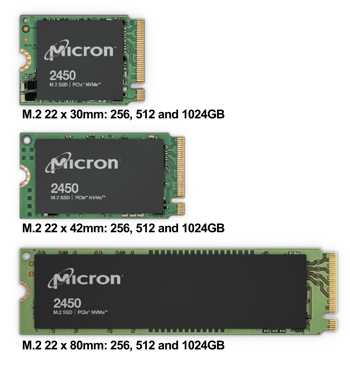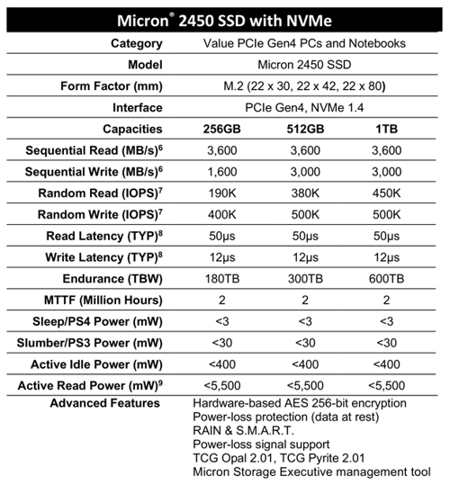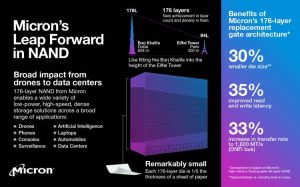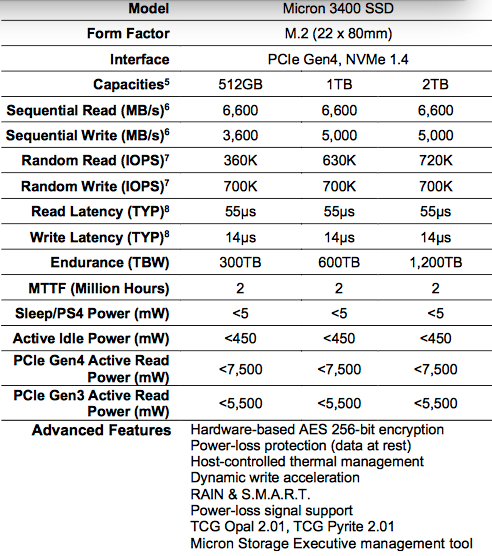Computex: Micron Unveils Memory and Storage Innovations Including 176-layer NAND and 1α DRAM Technology
As well as 3400 and 2450 M.2 SSD, 1α-based LPDDR4x and DDR4 memory, and 128 and 256GB 96-layer NAND portfolio of UFS 3.1 managed NAND products for automotive applications
This is a Press Release edited by StorageNewsletter.com on June 10, 2021 at 2:33 pmAt Computex, Micron Technology, Inc. unveiled memory and storage innovations across its portfolio based on its 176-layer NAND and 1α (1-alpha) DRAM technology, as well as the first Universal Flash Storage (UFS) 3.1 solution for automotive applications.
Click to enlarge
This portfolio additions deliver on the company’s vision of accelerating data-driven insights through innovations in memory and storage that enable new capabilities from the data center to the intelligent edge.
Sanjay Mehrotra, president and CEO, made the announcements during a Computex keynote, in which he shared a sweeping vision for computing innovation and the central role memory and storage play in enabling enterprises to seize the full potential of the data economy.
The company announced volume delivery of its first PCIe Gen4 SSDs built with the world’s first 176-layer NAND. It is also shipping the first 1α node-based LPDDR4x DRAM this month. LPDDR4x is the latest JEDEC spec for fourth-gen low-power DRAM with improved I/O voltage for substantially lower power, making it for mobile computing devices.
“As AI and 5G reach mainstream deployment, they are creating dramatic new potential for data in the post-pandemic world,” Mehrotra said. “This transformation presents an opportunity for accelerating innovation to address customer needs. Today we are debuting new memory and storage solutions that accelerate innovation, from powerful data center servers and faster client devices to intelligent vehicles at the edge.“
PCIe Gen4 SSD portfolio is designed to tackle demanding client applications
The company’s latest SSDs, the 3400 and 2450, deliver high performance and design flexibility with low power consumption to enable all-day use from professional workstations to ultrathin notebooks. The 3400 SSD provides twice the read throughput and up to 85% higher write throughput, (1) unleashing demanding applications like real-time 3D rendering, CAD, gaming and animation. For customers seeking the best value with PCIe Gen4 performance, the 2450 SSD delivers a responsive user experience for everyday use. The 2450 SSD is available in 3 form factors, as small as the 22x30mm M.2, to deliver immense design flexibility.

 “AMD was first to adopt PCIe 4.0 desktop processor and chipset support. As the ecosystem of AMD-supported platforms continues to grow, we are delighted to see partners like Micron expand their Gen4 SSD portfolio,” said Chris Kilburn, corporate VP and GM, client component business unit, Advanced Micro Devices, Inc. “In partnership with leading memory and storage companies like Micron, we are committed to delivering new levels of performance and efficiency to the PC market.“
“AMD was first to adopt PCIe 4.0 desktop processor and chipset support. As the ecosystem of AMD-supported platforms continues to grow, we are delighted to see partners like Micron expand their Gen4 SSD portfolio,” said Chris Kilburn, corporate VP and GM, client component business unit, Advanced Micro Devices, Inc. “In partnership with leading memory and storage companies like Micron, we are committed to delivering new levels of performance and efficiency to the PC market.“
Due to their advanced power efficiency, the 3400 and 2450 are listed on the Intel Modern Standby Partner Portal Platform Component List and meet the open labs’ SSD test requirements of Intel Project Athena. Additionally, both Micron SSDs have been validated for AMD’s PCIe Power Speed Policy and Windows Modern Standby.
Ships first 1α-based LPDDR4x and DDR4, now in volume production
The company is shipping LPDDR4x in volume on its 1α node this month, quickly following the introduction of initial 1α node DRAM products in January 2021. The company has also completed validation of its 1α-based DDR4 on leading data center platforms, including 3rd Generation AMD EPYC. Both are in volume production in the firm’s DRAM fabrication facilities in Taiwan, including its newly-established A3 facility in Taichung.
The swift market delivery of the company’s 1α-based memory provides technology to power innovation from data-centric workloads on server platforms to consumers’ slim notebooks. 1α enables power-efficiency improvements for memory, bringing mobility advantages for notebooks by enabling longer battery life both for the work- and study-from-home environments. Amid rising remote work and schooling trends, Micron has partnered with system providers around the globe to meet the soaring demand for PCs. These efforts include collaboration with Taiwan OEM Acer, Inc. on integrating 1α-based LPDDR4x and DDR4 into Acer systems.
“At Acer, our mission has always been to break the barriers between people and technology,” said Jason Chen, chairman and CEO, Acer. “We are working closely with Micron to introduce their most advanced 1α DRAM process node in Acer’s systems and provide high-performance, power-efficient personal computers for more people to stay connected across the world.”
The 1α node process also provides a 40% improvement in memory density and up to 20% improvement in power savings for mobile use cases when compared to previous 1z node LPDDR4x. This power savings is for mobile phones that must preserve battery life, particularly with memory-intensive use cases like capturing photos and video.
Delivers ruggedized storage engineered for data-intensive automotive systems
The company announced that it is sampling 128 and 256GB densities of its 96-layer NAND as part of its portfolio of UFS 3.1 managed NAND products for automotive applications. With infotainment systems evolving to include high-resolution displays and human-machine interface capabilities based on AI, the UFS 3.1 portfolio provides high-throughput and low-latency storage.
The UFS 3.1 offers 2x faster read performance than UFS 2.1, enabling fast boot times and minimizing latency for data-intensive in-vehicle infotainment and driver-assistance systems (ADAS). It also provides 50% faster sustained write performance to keep pace with real-time local storage needs of growing sensor and camera data for Level 3+ ADAS systems and black box applications. (2)
Market research and strategy consulting firm Yole Développement projects the market for NAND in automotive to grow to $3.6 billion in 2025, nearly quadrupling from $0.9 billion in 2020. (3) As vehicles become more software-centric, these new centers of data require performance storage to make large volumes of information readily available for near-instant processing. ADAS-enabled vehicles now contain over 100 million lines of code that must be stored and quickly read for snappier user experiences and quick decision-making at the edge.
“The new engine of the modern car utilizes centralized, high-performance compute to drive data-rich AI, computer vision and multi-sensor processing capabilities, resulting in a need for advanced storage and memory solutions,” said Vasanth Waran, senior director, product management, Qualcomm Technologies, Inc. “Micron’s UFS 3.1 portfolio is uniquely engineered and designed to meet the rigorous reliability and performance requirements of automotive environments, which equips OEMs to raise the bar for personalized, adaptive and context-aware digital cockpits. We look forward to working with Micron Technology to optimize its leading storage and memory solutions for use across our automotive platforms.“
Speeds market adoption of DDR5 with ‘Technology Enablement Program’
The company has also made momentum with its Technology Enablement Program (TEP) for DDR5, launched in 2020 to speed market adoption of the latest DRAM and prepare the ecosystem for the introduction of DDR5-enabled platforms, expected over the next year. The program has now engaged more than 250 design and technical leaders from more than 100 industry leaders, including system and silicon enablers, channel partners, cloud service providers and OEMs.
Resources:
Blog: Micron Advances Client SSDs With 176-Layer NAND PCIe Gen4 Portfolio
Blog: Automotive-Grade UFS 3.1 Brings the Latest Smartphone Performance to Your Car
Blog: Micron’s DDR5 Technology Enablement Program Empowers an Ecosystem
Blog: Doing What Can’t Be Done (Again) – Micron Ships 176-Layer NAND
(1) Compared to Micron’s prior-generation SSD, the Micron 2300
(2) Compared to its predecessor UFS 2.1
(3) Source: NAND Market Monitor Q1 2021 (€30,000)– Yole Développement
















 Subscribe to our free daily newsletter
Subscribe to our free daily newsletter

